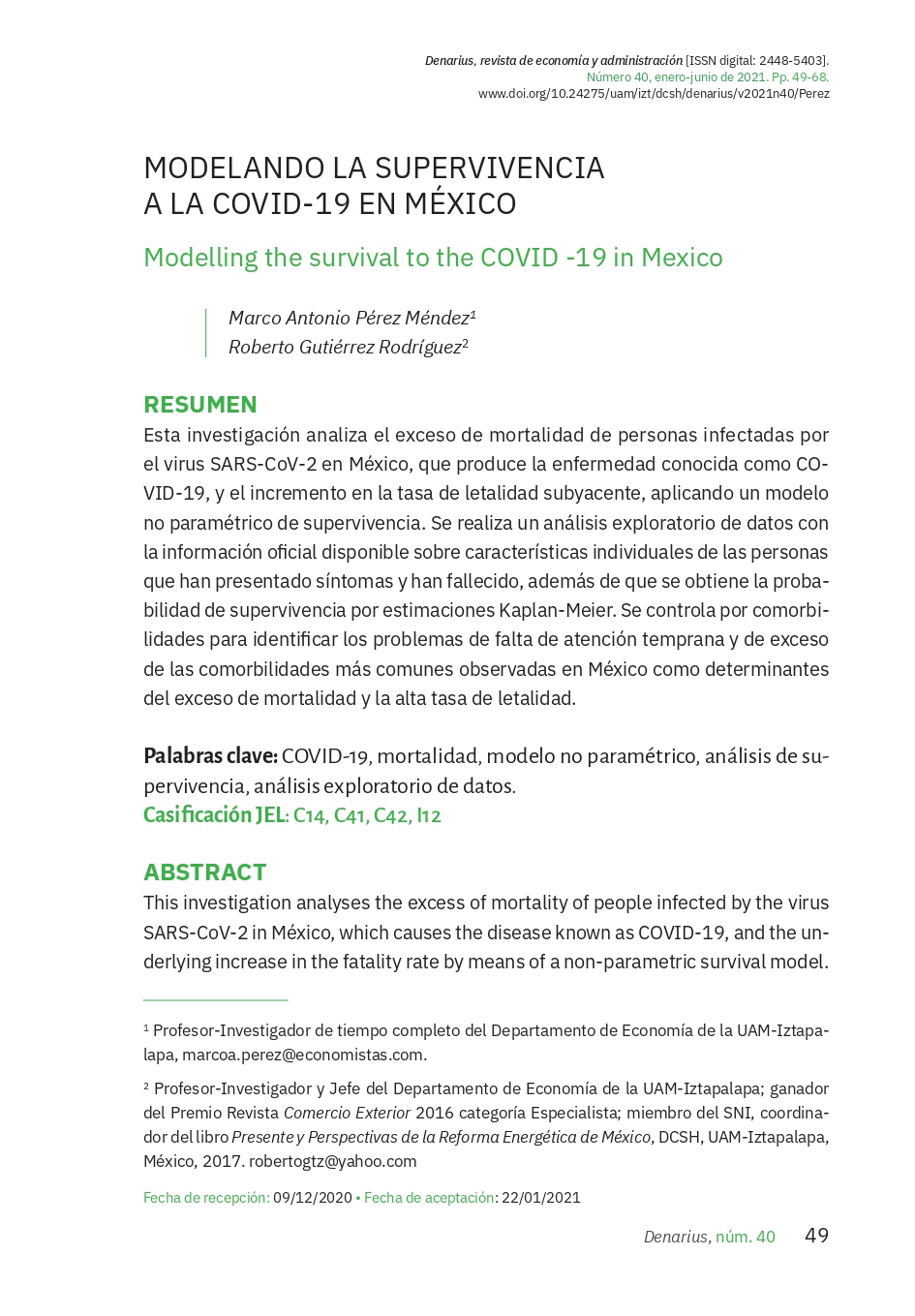Modelling the Survival to the COVID-19 en México
Abstract
This investigation analyses the excess of mortality of people infected by the virus SARS-CoV-2 in México, which causes the disease known as COVID-19, and the underlying increase in the fatality rate by means of a non-parametric survival model. An exploratory data analysis is carried out using the official information referred to the individual characteristics of those who have presented the symptoms and have passed away. Besides, the survival probability is obtained by means of Kaplan-Meier estimates. The process is controlled for comorbidities to identify the lack of early care and the excess of the most common comorbidities in Mexico as factors responsible for the excess of mortality and the high fatality rate.
Downloads
References
BOSTON Consulting Group (2020). Epidemic Projections. COVID-19 Response, Boston, marzo 26, 31 pp.
BWIRE, George (2020). Why men are more vulnerable to COVID-19 than woman? SN Compr. Clin. Med. 2, 874–876 (2020). https://doi.org/10.1007/s42399-020-00341-w
CASTAÑEDA, Jorge Andrés y Garrido S. (2020). “Como entender los datos de defunciones por COVID-19 en México?”. Nexos, mayo.
GOMPERTZ, Benjamin (1825). “On the Nature of the Function Expressive of the Law of Human Mortality”. Philosophical Transactions of the Royal Society of London, Vol. 115, pp. 513-583.
GLENNON D. y Nigro P. (2005). “Measuring the Default Risk of Small Business Loans: A Survival Analysis Approach”. Journal of Money, Credit and Banking. 37 (5): 923–947
GUTIÉRREZ Rodríguez, Roberto y Pérez Méndez, Marco Antonio (2020a). “Modelando la difusión del COVID-19 en México”. Boletines UAM No. 227. México, 13 de abril.
——.. (2020b). “La pandemia por COVID-19 se prolongará hasta abril de 2021”, La Crónica, 2 de julio.
——..(2020c). “La trayectoria del COVID-19 en México a partir de un modelo evolutivo”. Inédito, Departamento de Economía, UAM-Iztapalapa.
JOHN Hopkins University (2020). “Dashboard by the Center for Systems Science Engineering (CSSE). https://systems.jhu.edu/. Consultado entre abril y noviembre.
JUKIĆ, Dragan et al (2004), “Least-squares fitting Gompertz curve”, Journal of Computational and Applied Mathematics, 169: 2, pp. 359-375, en https://doi.org/10.1016/j.cam.2003.12.030. Consultado el 1 de abril de 2020.
KAPLAN, E. L.; Meier, P. (1958). “Nonparametric estimation from incomplete observations”. Journal of the American Statistical Association. 53 (282): 457- 481. JSTOR 2281868. doi:10.2307/2281868. Consultado el 20 de abril de 2020.
METCALFE, J. S. (1981). “Impulse and Diffusion in the Study of Technical Change”, Futures, octubre, pp. 347-359.
MOORE, D. F. (2016). Applied survival analysis using R. New York: Springer.
ORGANIZACIÓN de las Naciones Unidas (ONU) (2020). World Population Prospects 2019. https://population.un.org/wpp/. Consultado el 3 de agosto.
RICHARDS, S. J. (2012). “A handbook of parametric survival models for actuarial use”. Scandinavian Actuarial Journal. 2012 (4): 233–257.
ROMERO Zavala, Mario y Despeghel, L. (2020). “El exceso de mortalidad: un comparativo internacional”, Nexos, agosto.
——..(2020), “¿Qué nos dicen las actas de defunción?”, Nexos, agosto.
SECRETARÍA de Salud (Ssa) (2010), https://www.gob.mx/salud consultada diariamente.
SPIVAK, Andrew L.; DAMPHOUSSE, Kelly R. (2006). “Who Returns to Prison? A Survival Analysis of Recidivism among Adult Offenders Released in Oklahoma, 1985-2004”. Justice Research and Policy. 8 (2): 57–88.
STEPANOVA M., y THOMAS L. (2002). “Survival Analysis Methods for Personal Loan Data”. Operations Research. 50 (2): 277–289.
TJØRVE, K. M. C. y Tjørve E. (2017). “The use of Gompertz models in growth analyses, and new Gompertz-model approach: An addition to the Unified-Richards family”, PLOS ONE 12(6), en https://doi.org/10.1371/journal.pone.0178691, consultada el 2 de abril de 2020.
VERHULST, Pierre Francois (1838). “Notice sur la loi que la population pursuit dans son accroissement”, Corresp. Math. Phys. 10, pp. 113–121
WINSOR, Charles P. (1932). “The Gompertz Curve as a Growth Curve”, Proceedings of the National Academy of Science, Jan. 15, Vol. 18, pp. 1-8.














